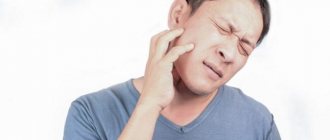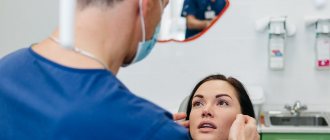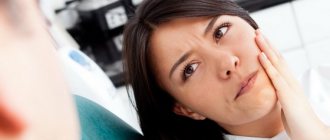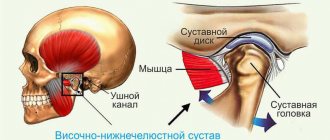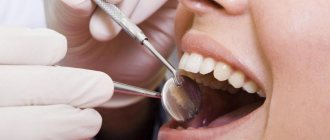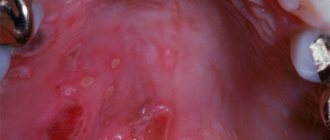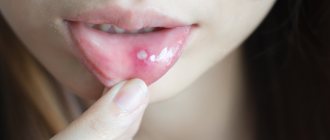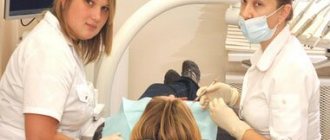Arthrosis of the TMJ is a pathology of the temporomandibular joint, which is caused by degenerative changes in the tissues. The disease manifests itself in the form of aching, dull pain in the joint area, clicking, crunching, stiffness when opening the mouth, and stiffness in jaw movement.
When diagnosing, the palpation method is used; arthrography, radiography, tomography, and EMG will also be prescribed. Treatment requires certain measures, including prosthetics, teeth grinding, physiotherapy, massages and other methods.
Arthrosis of the TMJ is a chronic disease, which is characterized by the development of degenerative processes and impaired functionality of the temporomandibular joint. This form of arthrosis is common in people over 50 years of age; it is diagnosed in almost 70% of patients over the age of 70 years. At a young age, the disease most often occurs in women.
Reasons for development
The causes of TMJ arthrosis are various factors, including:
- chronic arthritis;
- presence of malocclusion;
- partial edentia (usually caused by loss of lower molars);
- incorrect prosthetics or incorrect installation of fillings;
- the presence of injuries or operations in the temporomandibular joint;
- genetic predisposition;
- vascular, infectious, endocrinological diseases;
- hormonal imbalances (in women).
Treatment
Therapy consists of functional and orthopedic measures, which are included in complex treatment. The process of eliminating pathology can be conservative, surgical or reconstructive. Arthrosis of the mandibular joint can be treated:
- Conservatively, relieving pain and swelling, as well as muscle spasms.
- If necessary, the patient is prescribed reconstructive therapy. Its main purpose is to restore the correct position of the head of the assembly.
- Surgical technologies are aimed at performing arthroplasty. It is used in severe cases.
Timely treatment is the key to improving the quality of life. Neglecting the problem leads to ankylosis. The treatment program, if necessary, includes orthopedic measures, therapeutic exercises, and massage. Severe symptoms disappear when taking medications prescribed by the doctor. Patients are advised to wear a mouthguard, which helps eliminate teeth grinding. Patients use different technologies to relax the jaw muscles. It is imperative to provide rest to the pathological organ. To do this, a sling-shaped bandage is applied or interdental plates and splints are placed. To monitor the treatment, a repeat x-ray of the jaw is prescribed.
Chondroprotectors, corticosteroids, joint injections, and antibiotic therapy are used. It is important to normalize the ratio of the rows of masticatory organs and restore the masticatory muscles. To do this, doctors advise using restrictive devices. If the disease is infectious, mud therapy and electrophoresis are additionally prescribed. Novocaine blockades relieve severe neuralgic pain, UHF therapy is practiced. The patient's mode after surgery is semi-bed or bed rest. It depends on the complexity of the intervention and concomitant pathologies. A special soft diet is prescribed.
Classification and symptoms of TMJ arthrosis
There are four stages of the disease:
- the initial stage, during which instability of the joint and uneven narrowing of the joint space are observed;
- pronounced stage with extensive symptoms;
- late stage with limited TMJ function, signs of bone and cartilage degeneration;
- advanced stage with the development of fibrous ankylosis of the TMJ.
The main symptoms of the disease are:
- crunching, clicking, joint stiffness, especially in the morning;
- dull pain with frequent functional loads;
- constant and aching pain that appears as the disease progresses;
- limitation of range of motion, displacement of the jaw to the affected side;
- headache;
- hearing loss;
- tingling skin, otalgia, feeling of numbness in the affected area.
Prevention
It is better to prevent arthrosis of the jaw than to treat it. Preventive measures are based on regular sanitation of the oral cavity, purulent chronic foci, and treatment of acute infectious diseases. It is important to prevent injury to the node. For a favorable prognosis of the disease, rational prosthetics, timely normalization of bite defects, and treatment of concomitant pathologies are used.
Patients diagnosed with arthrosis of the TMJ are registered at the dispensary. Dentists provide the necessary therapeutic courses. The doctor may prescribe oral irrigation with antiseptic solutions. It is necessary to adjust the splints daily and change the intermaxillary traction. It is necessary to cure endocrine and somatic diseases that become provoking factors of pathology. Patients should lead a healthy lifestyle, protect themselves from stress, and eat a balanced and healthy diet.
Diagnosis, treatment and prognosis
| Click to sign up for a FREE consultation |
Diagnosis of the disease includes a number of radiological, clinical, and functional methods. When visiting a doctor, the oral cavity will be examined, complaints will be collected, and the existing range of motion will be determined. The examination also uses a diagnostic jaw model.
X-rays can detect pronounced signs of the disease; CT scans can identify early signs, which is important for timely treatment. In addition, consultations with an orthodontist, endocrinologist, rheumatologist and other related specialists will be scheduled. Among the prescribed studies are rheography, arthrophonography, axiography, and gnathography.
After receiving the diagnostic results, the patient will be prescribed physiotherapeutic, orthodontic, therapeutic and other procedures. During the entire treatment period, it is necessary to follow a gentle diet, which will help reduce the load on the joint. In addition, heavy loads on the jaws, including speaking and chewing, are eliminated.
At the initial stage, factors that lead to joint overload are eliminated to relieve pain, NSAIDs are used in the form of ointments and tablets. In later stages, measures such as removal of the articular head or disc and subsequent installation of a graft are indicated.
A favorable prognosis can be given only in case of timely treatment of the disease, rational prosthetics, normalization of the bite, and elimination of concomitant diseases. At an advanced stage, it will not be possible to completely restore lost functions without surgery. But even after a successful operation, regular follow-up with a dentist is recommended.
Diagnostics
To cure the disease, a number of studies are necessary. Only an integrated approach to diagnosis will help make the correct diagnosis.
- First, the patient’s oral cavity is examined, an anamnesis is collected, complaints are identified, and the node is palpated.
- The muscles of the head and neck are examined.
- X-ray examinations are being carried out. Most often, TRH is prescribed in the lateral projection.
- A full neurological evaluation may be required.
- Artography, computed tomography, and MRI have a high degree of information content.
An x-ray shows defects in the affected area and degenerative bone pathologies. Areas of osteoporosis may appear. If the doctor is in doubt, it is recommended to undergo a morphological zonal analysis. According to indications, cartilage cells are studied, fatty degeneration is detected, EMG and orthopantomography are performed. The amplitude of movement must be assessed.
Classification of TMJ arthritis
The nature of the course of arthritis implies the presence of acute and chronic forms. The acute form of this disease is characterized by a serous and purulent course. There is also a classification of TMJ arthritis, depending on the etiological origin:
- traumatic arthritis;
- infectious arthritis (nonspecific and specific);
- rheumatoid arthritis;
- other rare forms (reactive arthritis and others).
Specific infectious inflammations of the TMJ include: syphilitic, tuberculous, actinomycotic, gonorrheal, etc.
Clinical picture
Symptoms primarily depend on the stage of development of arthrosis. The main symptom is a constant dull aching pain. When the jaw moves, the joint begins to crunch and click.
In addition, the patient may feel stiffness in the movement of the joint (most often manifests itself after sleep). The pain occurs when eating, so you have to chew on only one side.
In advanced cases, the patient has great difficulty opening his mouth at all. The jaw moves to the side, the asymmetry of the face is disrupted. To avoid irreversible consequences, it is necessary to treat the disease at an early stage.
Folk remedies
With the permission of a doctor, non-traditional methods of treating arthrosis of the jaw joint can be used. There are both simple and complex traditional medicines to prepare. For example, warming with salt or sand is a great way to cope with pain. They need to be warmed up, poured into a textile bag and applied to the affected jaw for 1.5-2 hours until completely cooled. Another simple recipe is to use raw egg whites. At night, apply it to the entire jaw and the area behind the ears.
Among the more labor-intensive, but also more effective folk remedies, the following can be distinguished:
Drops based on celandine
- Mix crushed and squeezed celandine through cheesecloth with honey in a 1:1 ratio.
- When the honey is completely dissolved, the medicine is ready.
- Place 1 drop in each nostril before bedtime. In the first few days, this treatment may cause discomfort, but over time the effect will be noticeable.
Solution for compresses
- Mix 5 g of the following components: rhizomes of elecampane, burdock and horseradish, leaves and flowers of mint, St. John's wort, lemon balm, celandine, calendula, eucalyptus, plantain, juniper fruits.
- Grind the raw materials and pour in hot corn oil.
- After cooling, the solution is freed from all solid ingredients.
- Add 5 g of bee bread and propolis to the resulting liquid.
- Infuse the medicine in a warm place for about 20 minutes.
- At this time, mix 100 g of gum turpentine with 15-20 g of gum rosin.
- After 20 minutes, mix both solutions.
- Use the resulting mixture as compresses at night.
TMJ diseases
Diseases of the TMJ (temporomandibular joint) are characterized by a common symptom - dysfunction of the masticatory apparatus - and are the competence of orthopedic dentistry.
Arthrosis of the TMJ
Arthrosis of the TMJ is a disease that occurs as a result of uneven load on the joint: on the one hand, compression, and on the other, stretching. Increased loads can occur due to malocclusion, occlusion and articulation, as well as if incorrect prosthetics were performed (insufficient examination, poorly fixed fixed prosthesis, incorrectly sized bridge, excessive grinding of the tooth for a crown).
Symptoms of TMJ arthrosis:
- Pain in the joint in a calm state, inactivity;
- Clicking and crunching in the joint;
- Stiffness in the lower jaw after a night's sleep or after prolonged exercise (long conversation, chewing food);
- Limited mouth opening;
- Moving the jaw to the side when opening the mouth.
Treatment
The treatment of arthrosis of the TMJ requires an integrated approach from a group of doctors:
- Orthopedic treatment – corrects malocclusion – straightens the shape of the teeth, corrects the relationship of the dentition, installs or replaces previous dentures;
- Therapeutic treatment – partial grinding of teeth that interfere with the normal closure of the jaws;
- Physiotherapeutic methods – galvanization, massage, electrophoresis.
Arthritis of the TMJ
TMJ arthritis is inflammation of the temporomandibular joint of infectious or non-infectious origin. Initially, it spreads only to the joint capsule, then it can reach areas of the bone, accompanied by the melting of cartilage and the appearance of connective tissue in the joint cavity.
There are two stages of the disease: acute and chronic. When acute pain becomes severe, visible deformation of the face and swelling are observed. The joint is constantly stiff. In the chronic stage, painful sensations increase with movement, and in an immobilized state they are moderate or weakly noticeable. The joint is stiff in the morning.
Symptoms of the disease:
- Acute throbbing pain when moving the joint (talking, chewing), radiating to the temple, back of the head;
- Pain on palpation of the lower jaw;
- Redness of soft tissues and their swelling;
- Feeling of fullness in the jaw.
Treatment
- Immobilization of the diseased joint by applying a sling-shaped bandage to the lower jaw or other methods;
- A diet that excludes chewing food for 3 days;
- Using analgesics and cold compresses for pain relief;
- Taking antibiotics, injections of chondroprotectors and corticosteroids into the joint;
- Physiotherapeutic measures – mud therapy, ultraphonophoresis.
Ankylosis of the TMJ
Ankylosis of the TMJ is a partial or complete loss of mobility of the lower jaw, which is caused by fibrous or bony fusion of the joint surfaces. The danger of this disease is that it can occur for many years without symptoms until the cartilage completely dies. Bone ankylosis develops in childhood, while fibrous ankylosis occurs in adults.
Symptoms of the disease:
- Limitation in opening the mouth;
- Impaired breathing (night apnea and snoring), speech, chewing;
- Distortion of the face to the side;
- Shortened and underdeveloped lower jaw;
- Increased formation of plaque and tartar.
Treatment
The treatment has two goals: restoring joint mobility and facial aesthetics.
In the first stages, treatment may be limited to physiotherapeutic measures in the form of ultraphonoresis, hyaluronodase, as well as hydrocortisone injections into the joint. Sometimes they resort to mechanical expansion of the jaws under anesthesia or surgical dissection of the adhesions.
Persistent deformities and adhesions in late stages of development can only be eliminated surgically. The complexity of the operation should be taken into account due to difficulty breathing in patients with this disease. In some cases, a tracheotomy is required.
Ankylosis can be prevented by timely treatment of diseases of the facial joints and birth injuries in children.
Musculo-articular dysfunction of the TMJ
Impaired coordination of the muscles of the lower jaw and the joint, as well as the placement of the head and disc of the joint relative to the tubercle. Factors that contribute to the development of this disease may be incorrect orthodontic treatment, unprofessional implantation, bone grafting of teeth, sinus lifting, as well as endocrine, articular and other diseases.
Symptoms:
- Painful sensations in the jaw, increasing at night and with movement (in another form, painful sensations may be absent);
- Clicking sounds when moving the jaw;
- Temporary stiffness in jaw movement;
- Tension of the facial muscles, most often one-sided;
- Sleep disturbance.
Treatment
The main task is to create the correct bite for the patient and restore normal jaw closure. These tasks are carried out by grinding protruding contacts on the surface of the teeth, which interfere with the normal closure of the jaws. Advanced stages can only be treated surgically - dissection of adhesions, straightening and installation of the disc in place.
TMJ dislocation
TMJ dislocation is a displacement of the head of the joint beyond its normal location, in which the function of the lower jaw is completely disrupted. There are 2 types:
- traumatic – resulting from a blow to the jaw, yawning or screaming;
- habitual - which develop as a result of stretching of the joint capsule and ligaments.
Symptoms:
- The lower jaw is displaced downwards, the mouth does not close on its own;
- Excessive salivation;
- The appearance of depressions in the area of the tragus of the ear and protruding heads of the joint in the area of the cheekbones;
- Strong pain.
Treatment
- Reduction of the joint;
- Immobilization of the TMJ.
Contacting the Denta Lex clinic
In order to find out in detail what products the doctors at the Denta Lex clinic use to treat TMJ, and what price you will need to pay for therapeutic measures, just contact the clinic using the phone numbers listed on the website. During the telephone conversation, the operator will answer all questions that arise. This way you will be able to clarify not only the price, but also the duration of therapy, features of the procedure, find out the level of qualifications of the doctor and take advantage of the opportunity to make an appointment in advance.
The peculiarity of treatment at the Denta Lex clinic is that it is based on an individual approach to solving the existing problem. The most modern equipment is installed here for instrumental examination and other procedures. All therapeutic measures are carried out at the modern level with the prescription of effective medications.
Before the patient undergoes completely safe and painless, but very effective procedures, doctors will accurately determine the essence of the problem, which will allow it to be solved with the highest quality and in the shortest possible time.
How does pathology develop?
Regular exposure to negative factors leads to gradual dysfunction of the joint. At the initial stage of pathology development, these processes are reversible. Arthrosis develops when the load on the joint becomes greater than its endurance.
Incorrect bite and missing teeth can cause displacement of the jaw head. This leads to a disruption in load distribution. In addition, the nutrition and functionality of the joint are also impaired. Over time, the cartilage on the surface of the joint head begins to deteriorate.
Cysts may begin to grow in the bone apparatus. Over time, the head of the joint becomes deformed.
How dangerous is the disease?
Often, arthrosis of the jaw in the first stages is asymptomatic, which leads to prolonged inactivity in the treatment of the pathology. However, ignoring the disease is dangerous. If you notice at least one of the symptoms, you should visit a doctor. In advanced forms of pathology, medications, orthopedics and even surgery are used.
The risk group includes persons:
- over 50 years old;
- females who have reached menopause;
- those who have had injuries and surgeries of the jaw;
- with malocclusion, diseases in the jaw area;
- with damaged or missing teeth;
- with chronic inflammatory diseases;
- with arthrosis of other joints;
- whose family members suffer from jaw joint dysfunction.
